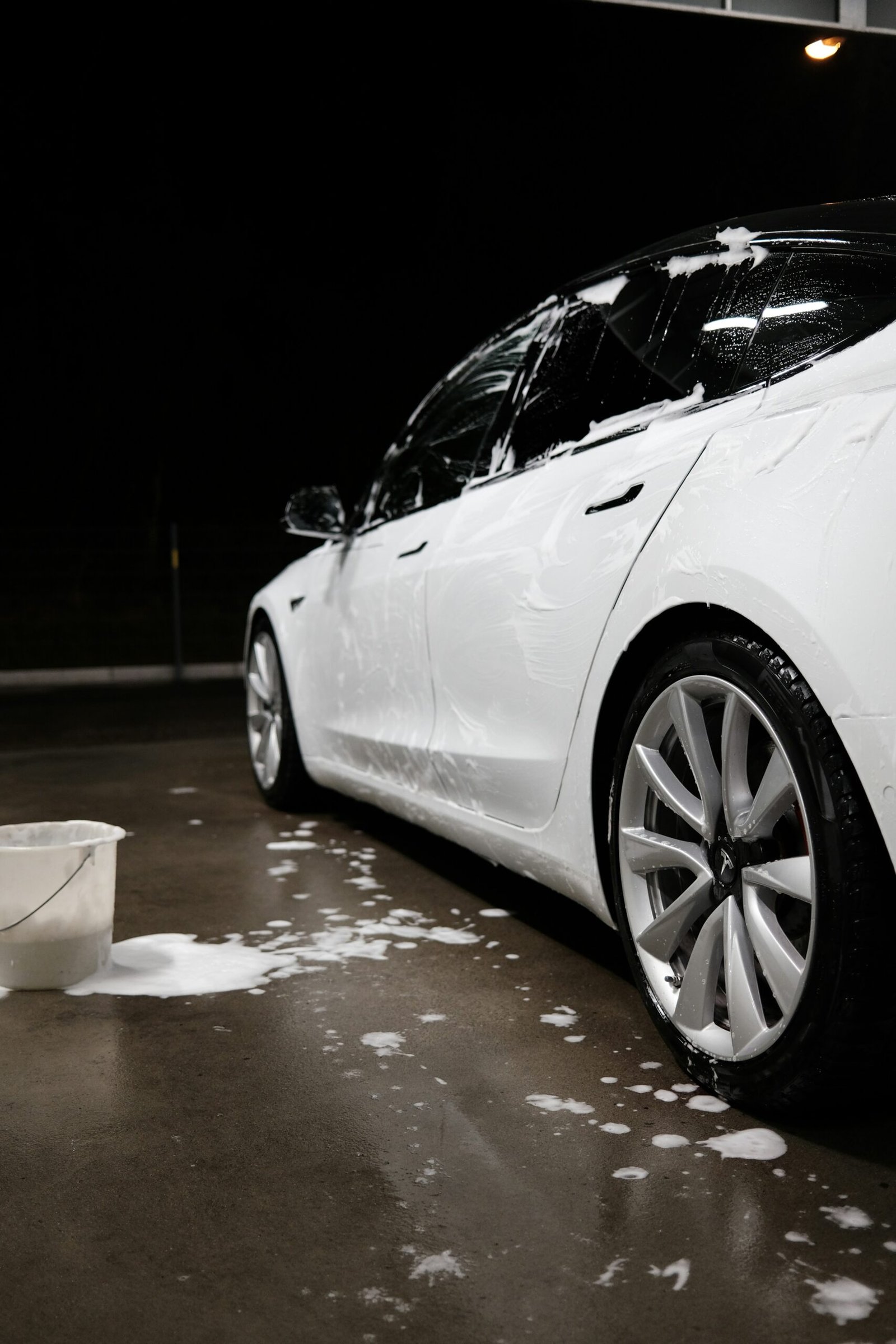Introduction to Car Detailing
Car detailing is a comprehensive cleaning and restoration process that goes beyond the surface level, ensuring that both the exterior and interior of a vehicle are meticulously maintained. Unlike a regular car wash, which primarily focuses on removing dirt and grime through basic washing techniques, detailing delves into the intricate components of a car. It involves a thorough cleaning, rejuvenation, and protection of various surfaces, including paint, upholstery, and even the engine bay.
The significance of car detailing lies not only in its ability to improve a vehicle’s aesthetic appeal but also in its role in extending the lifespan of the vehicle. Regular detailing helps to maintain the vehicle’s paint and finish, preventing fading and oxidation caused by exposure to harmful environmental factors such as UV rays, acid rain, and road salt. Additionally, detailing provides crucial protection against contaminants like bird droppings, tree sap, and industrial fallout, which can cause permanent damage if left untreated.
Another paramount benefit of car detailing is the enhancement of the car’s resale value. A well-maintained car, with its interiors and exteriors meticulously detailed, creates a positive impression on potential buyers. When the vehicle looks its best, it can command a higher selling price and facilitate a smoother sale process. Moreover, detailing services often include the application of wax, sealants, or ceramic coatings, which serve to protect the paint and add a brilliant shine, further elevating the vehicle’s market appeal.
In summary, car detailing is a vital practice for maintaining the integrity and beauty of a vehicle. With its ability to provide both aesthetic and protective benefits, it stands as a worthwhile investment for any car owner seeking to keep their vehicle in prime condition for years to come.
Essential Tools and Products for Car Detailing
To achieve a professional-level car detailing result, it is critical to equip oneself with the right tools and products. A comprehensive set of supplies can streamline the detailing process, ensuring both the exterior and interior of the vehicle are adequately cleaned and preserved.
Start with the basics: a pair of high-quality buckets. It’s advisable to have one dedicated to soapy water and another for rinsing, as this practice helps minimize the risk of dirt reintroducing itself to the surface. Additionally, a grit guard that fits into the bottom of each bucket can help trap dirt particles and prevent them from scratching the car’s paint.
Microfiber cloths are indispensable tools in car detailing. They are perfect for drying surfaces and effectively removing dust without causing scratches. Opt for different varieties—some for polishing and others for general cleaning. For scrubbing tires and wheels, a set of dedicated brushes with varying stiffness will yield the best results. A soft-bristled brush is ideal for delicate surfaces, while a firmer brush can tackle rubber and tires more effectively.
In terms of vacuums, a wet/dry vacuum can be particularly beneficial. These versatile machines are not only capable of picking up dust and debris but can also manage spills, making them suitable for interior detailing. Don’t forget specialized attachments that can reach tight spaces or many crevices within the car’s interior.
For cleaning solutions, choose pH-balanced products that are safe for both the exterior and interior surfaces. Recommendations include a gentle car wash shampoo, a high-quality glass cleaner, and dedicated interior cleaners for different materials like leather or fabric. For exterior protection, a good wax or sealant can significantly enhance shine and protect the paint. Quality brands to consider include Meguiar’s, Chemical Guys, and Adams Polishes, known for their trusted formulations in car detailing.
Preparing Your Vehicle for Detailing
Before embarking on the detailing process for your vehicle, it is essential to take a few preparatory steps. The first task is to find a suitable location where you can perform the detailing. Ideally, this should be a well-ventilated area that is free from environmental contaminants. Consider using a garage or a shaded outdoor space to avoid direct sunlight, which can cause cleaning products to dry too quickly and may lead to uneven application.
Gathering all necessary supplies is another crucial step in preparation. A comprehensive detailing kit may include car wash soap, microfiber cloths, a bucket, wax, polish, and various brushes. Additionally, you should have specific products for cleaning the interior, such as upholstery cleaner, glass cleaner, and leather conditioner, if applicable. Having everything at hand will streamline the process and prevent unnecessary interruptions.
Before you start cleaning, it is wise to remove any personal belongings from inside the vehicle. This includes items such as bags, electronics, and any rubbish that may have accumulated over time. Furthermore, take out any accessories such as floor mats or sunshades. This will not only create more space for effective cleaning but also protect your personal items from potential damage during the detailing process.
Finally, ensure that the vehicle is in a manageable state for detailing. A quick inspection for any loose parts or physical damages can save time later. By adequately preparing your vehicle for detailing, you create an efficient workflow and yield better results in both the interior and exterior cleaning endeavors. Taking these preliminary steps will enhance the overall detailing experience, resulting in a well-maintained and presentable vehicle.
Step-by-Step Guide to Exterior Detailing
Detailing a car’s exterior is a comprehensive process that enhances its appearance and protects the paintwork. The first step in this transformation is washing the vehicle. Begin by selecting a pH-balanced car shampoo and a soft microfiber wash mitt. Start at the top of the car, working your way down to avoid redistributing dirt. Rinse the mitt frequently to prevent scratches. Ensure you rinse the car thoroughly to remove all suds, and dry it with a clean microfiber towel to avoid water spots.
Once the vehicle is clean, the next step is clay bar treatment. This process removes embedded contaminants from the paint surface that washing alone cannot eliminate. To use the clay bar, knead it until it is pliable, then lubricate the surface with a clay lubricant. Gently glide the clay bar over the paint, feeling for smoothness. After the entire car has been treated, wipe away any residue with a microfiber cloth.
The third phase involves polishing, which helps to eliminate fine scratches and swirl marks. Choose a polish suited to your paint type and apply it using a dual-action polisher for best results. Work in small sections, applying even pressure and using overlapping passes. This ensures an even finish while reviving the paint’s gloss.
Following polishing, waxing is vital for protection. Select a high-quality car wax, whether liquid or paste, and apply it with an applicator pad. Work in circular motions, allowing it to haze before buffing off with a clean microfiber cloth. This step not only enhances shine but also provides a protective barrier against environmental elements.
Lastly, clean the windows and tires. For glass, use a dedicated glass cleaner to achieve a streak-free finish. For tires, a tire cleaner can be applied to remove grime, followed by a tire dressing to restore the rubber’s shine. Carefully follow each of these steps to ensure your vehicle’s exterior looks pristine and well-maintained.
Step-by-Step Guide to Interior Detailing
Detailing the interior of a vehicle can significantly enhance its overall aesthetic and comfort. To begin, it is essential to clear out any personal items from the car, including trash, tools, or any miscellaneous objects. This step allows for a more thorough cleaning process.
Once the vehicle is emptied, the next phase is vacuuming. Start with the seats; utilize a vacuum with an upholstery attachment to remove dirt and debris from fabric or leather seats. Ensure that you also vacuum the carpets and mats, paying attention to hard-to-reach areas such as under the seats. For mats, a more rigorous cleaning may be necessary; consider removing them from the vehicle for a detailed shake-out or brushing to eliminate stubborn grime.
After vacuuming the seats and carpets, it is necessary to wipe down all surfaces within the interior. For this task, use a soft microfiber cloth and an appropriate cleaning solution. Focus on areas like the dashboard, center console, and door panels, where dust and fingerprints tend to accumulate. It’s advisable to use products specifically designed for the materials being cleaned, ensuring their integrity is maintained.
If the vehicle features leather upholstery, applying a quality leather conditioner is highly recommended. This treatment not only cleans but also preserves the material, preventing cracking or fading over time. For vinyl surfaces, a gentle plastic cleaner or conditioner can restore and protect the finish.
Finally, deodorization is the finishing touch to a clean interior. Utilize an odor eliminator or a mild air freshener to neutralize any unpleasant smells. Ensure that the interior is well-ventilated during this phase to achieve the best results. Following these steps will lead to a refreshed and well-maintained vehicle interior.
Common Mistakes to Avoid While Detailing
Detailing a car can elevate its appearance and prolong its lifespan, yet some common mistakes can detract from these benefits or even cause damage. One of the most prevalent mistakes is using the wrong cleaning products. Not all cleaners are suitable for every surface; for instance, an all-purpose cleaner may damage upholstery or leave residue on leather. It is crucial to use products specifically designed for the surface being treated to ensure optimal results. Always check labels and choose products that are compatible with both the interior and exterior materials of the vehicle.
Another frequent error occurs during the washing process. Many detailers, especially novices, rush through the cleaning phase. This often involves using a single towel for drying and wiping surfaces, which can trap dirt and cause scratches. Implementing a two-bucket wash method—one for the soapy mixture and another for rinsing the wash mitt—can significantly reduce the risk of paint damage. Additionally, using separate microfiber towels for different surfaces can help maintain cleanliness and prevent cross-contamination.
Individuals often neglect certain areas that require attention. Commonly overlooked sections include the wheel wells, door jambs, and areas underneath the seats. These overlooked parts can accumulate dirt and grime, leading to a less-than-stellar overall appearance. To avoid this pitfall, create a thorough detailing checklist that encompasses all areas of the vehicle. Also, consider using specialized tools like brushes for intricate spots or detailing swabs for hard-to-reach areas.
Lastly, many detailers underestimate the importance of drying techniques. Employing improper drying methods, such as air drying, can result in water spots and streaks. Instead, always blot surfaces with a plush towel, ensuring comprehensive coverage. By being mindful of these frequent mistakes, detailers can enhance their techniques and achieve a polished, professional finish.
Tips for Maintaining a Detailed Vehicle
Maintaining the cleanliness and condition of a freshly detailed vehicle requires commitment and routine. To ensure that the exterior and interior remain in top shape, car owners should establish a consistent cleaning schedule. Regular washing of the vehicle is essential; it is recommended to wash the exterior at least once every two weeks. This practice not only removes dirt and road grime but also prevents contaminants from damaging the paint and trim. Choosing a pH-balanced car shampoo can significantly enhance the longevity of the detailing work, as it is less likely to strip away protective waxes and sealants.
In addition to washing, applying a protective coat of wax or sealant every few months will safeguard the paint against UV rays and environmental pollutants. For the interior, routine vacuuming should be prioritized to remove debris and dirt particles from carpets and upholstery. Utilizing a high-quality vacuum cleaner with appropriate attachments can make this task easier and more effective.
Implementing protective measures, such as using floor mats and seat covers, is an excellent way to maintain the vehicle’s interior. These accessories can trap dirt and spills, making cleaning much simpler. Furthermore, it is advisable to limit exposure to sunlight by parking in shaded areas or using sun shades on the windshield, reducing fading and deterioration of internal materials.
Easy maintenance tips include keeping a microfiber cloth and a spray bottle of detailing solution in the vehicle for quick touch-ups between thorough cleanings. Spot cleaning of minor stains and spills can prevent them from setting, thereby prolonging the integrity of upholstery and surfaces. By developing a regular maintenance routine and taking protective actions, car owners can ensure that their detailed vehicles continue to look pristine and well-cared-for over time.
Environmental Considerations and Eco-Friendly Products
Car detailing is often perceived as a meticulous and rewarding task, but it also brings with it important environmental considerations. The detailing process can impact the environment through the use of harsh chemicals and excessive water consumption. Traditional car cleaning products may contain toxic substances that can harm water quality and local ecosystems when washed off into storm drains or natural waterways. Thus, adopting eco-friendly car detailing practices is essential for minimizing these negative effects.
Fortunately, there is a growing range of eco-friendly car detailing products available today. These alternatives are formulated from biodegradable ingredients and do not contain harmful pollutants that can leach into the environment. Products labeled as “green” or “environmentally friendly” often use natural surfactants and oils, making them effective yet safe for both the car owner and the surroundings. For instance, opting for waterless car wash solutions can greatly reduce water usage while effectively cleaning the vehicle’s surface.
Water conservation is another critical aspect of eco-friendly car detailing. Traditional methods of washing a car can consume significant amounts of water, sometimes upwards of 100 gallons. By utilizing techniques such as rinseless washing or employing a two-bucket method, detailers can significantly limit water waste. Additionally, this method allows for better workflow and enhances the quality of the detailing process. Encouraging the use of reusable microfiber cloths instead of single-use paper towels further contributes to waste reduction during car care.
In conclusion, shifting towards eco-friendly products and practices in car detailing not only protects the environment but can also lead to lasting results on the vehicle. By being mindful of our choices, we can contribute positively to our surroundings while maintaining our cars in pristine condition.
Conclusion: The Benefits of DIY Car Detailing
In conclusion, engaging in DIY car detailing offers numerous advantages that extend beyond merely achieving a polished appearance. The process allows vehicle owners to develop a deeper understanding of their car’s needs, enhancing the relationship between the owner and the vehicle. Properly detailing both the exterior and interior not only restores the vehicle’s aesthetic appeal but also plays a pivotal role in maintaining its value over time.
Regularly undertaking car detailing tasks can lead to substantial long-term savings. By personally managing the detailing process, owners can avoid the financial burden of relying on commercial services, which can be considerably expensive. Furthermore, consistent DIY maintenance can prevent minor issues from escalating, thus extending the lifespan of various components and avoiding costly repairs. This proactive approach embodies a sense of responsibility and ownership that many car enthusiasts cherish.
The benefits of DIY car detailing also extend to improving the driving experience. A clean interior enhances comfort and promotes a healthier environment by eliminating dust, allergens, and odors. Likewise, a well-maintained exterior not only enhances the car’s aesthetics but also protects it from elements such as UV rays, dirt, and pollutants. This proactive care can ultimately lead to better performance and reliability as the vehicle ages.
Additionally, DIY car detailing fosters a fulfilling hobby that encourages learning and personal growth. As individuals explore various techniques and products, they cultivate skills that can be applied to other areas of life. Whether it involves mastering the art of waxing or understanding the intricacies of proper interior cleaning, the knowledge gained from this practice can be both enriching and rewarding.
Ultimately, taking pride in the DIY car detailing process allows vehicle owners to ensure their investment remains in top condition while enjoying a sense of accomplishment in their efforts.



